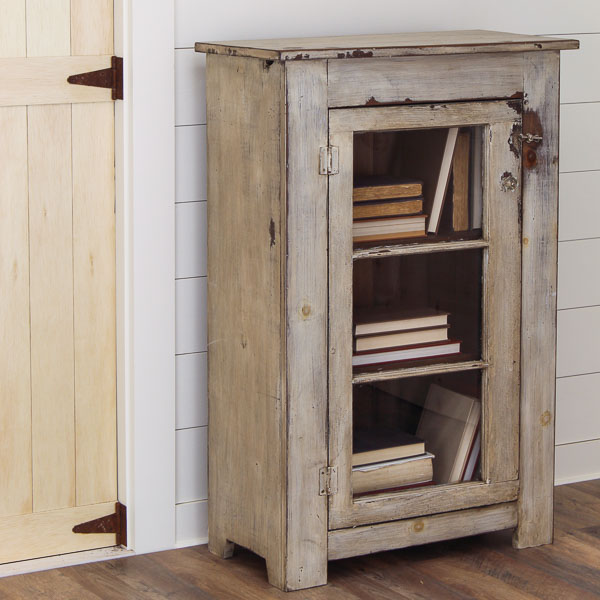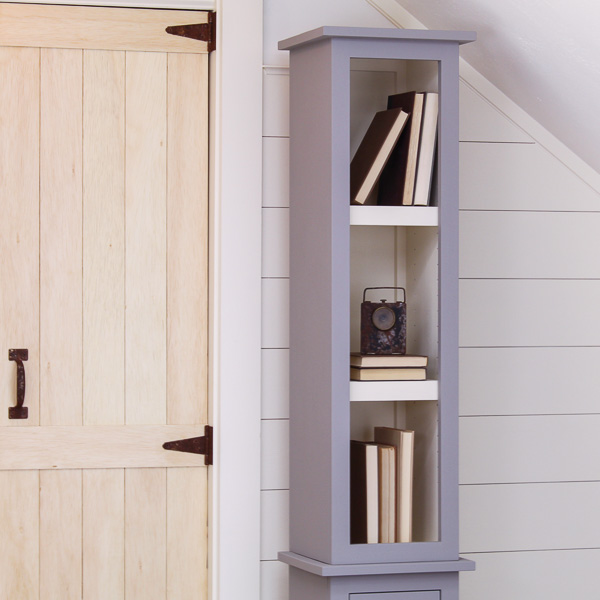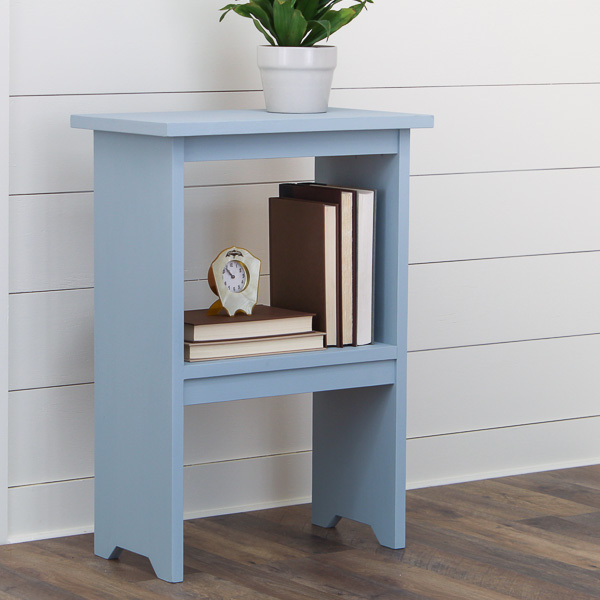Small DIY Bookshelf
Searching for a small DIY bookshelf that not only looks great but is also functional and easy to make? Then these free, step-by-step plans are for you!
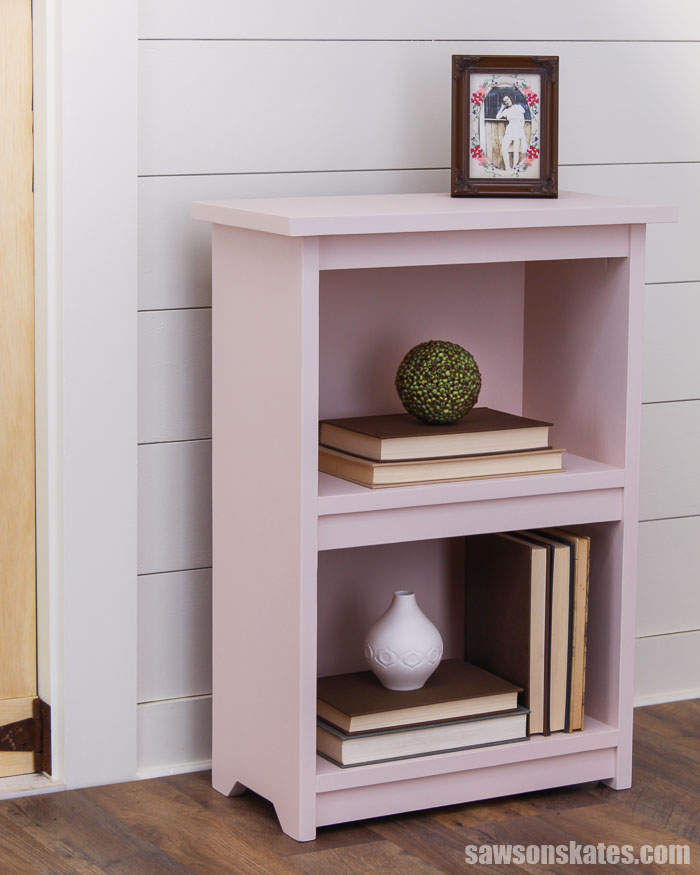
Small DIY Bookshelf Plans
This wood bookshelf is an easy afternoon do-it-yourself project. It’s made with a few straight cuts and just a few common tools.
The simple style complements nearly any decor. The small size makes this bookcase a smart choice for any room.
Up top, there’s space for a lamp, a plant, to set a drink or charge your devices.
Below, two shelves provide storage space to organize a book collection, magazines, or display your favorite home decor pieces.
Get the free plans and build one (or two) today!
This tutorial contains affiliate links to supplies and tools. Purchases made using these links help support the Saws on Skates website and allows me to share more projects and tips with you. There is no cost to you for using these links. Visit my site policies for more information.
Before we get into how to build a small DIY bookshelf, be sure to click the subscribe button at the bottom of this page to sign up for my FREE weekly newsletter loaded with helpful pocket hole tricks, space-saving workshop ideas, clever DIY tips and more!
Table of Contents
- Inspiration for this DIY Project
- Where to Use a Small DIY Bookshelf
- What Tools Do You Need to Make a DIY Bookshelf?
- What Wood Should I Use to Build a Bookcase?
- How Do You Finish the Bookshelf?
- Customize Your Bookshelf
- Where to Use This Bookshelf
- Simple DIY Bookshelf Tutorial
- Get the Free Printed Plan
Inspiration for this DIY Project
This small homemade bookshelf is easy to make. It’s basically a simple box with four sides and a back. In other words, if you can build a box, you can build this project!
The design for this bookcase was inspired by this DIY side table.
Only a few changes were needed to turn the side table into a bookshelf. The top was made a little narrower, a second shelf was added, and a panel was added to the back.
Back to Table of ContentsWhere to Use a Small DIY Bookshelf
- Kids room
- Living room
- Kitchen
- Bathroom
- Bedroom
- Guest Bedroom
- Office
- Craft room
What Tools Do You Need to Make a DIY Bookshelf?
This bookcase can be made in an afternoon using basic woodworking skills and just a few common woodworking tools. Tools like a miter saw, pocket hole jig, and a drill. You will also need an additional saw to cut the back of the bookshelf.
Miter Saw
I used a miter saw to cut all of the parts to length for this project.
Related: 7 Miter Saw Tricks Every DIYer Should Know
Pocket Hole Jig
I used a Kreg Jig to make pocket holes to join the parts for this project. You can use any pocket hole jig to drill the pocket holes. If you don’t have a pocket hole jig, the Kreg Jig 320 is a great choice for this woodworking project. The 320 is user-friendly and relatively inexpensive.
Related: What Kreg Jig Should You Buy?
Additional Saw
We’ll need an additional saw to cut the hardboard for the back of the bookcase. I used a table saw to cut the back. If you are not comfortable using a table saw, you could use a circular saw instead.
A circular saw and a Kreg Rip-Cut or Kreg Accu-Cut could be used to cut the hardboard to size.
Related: 4 Ways to Make Straight Cuts with a Circular Saw
Back to Table of ContentsWhat Wood Should I Use to Build a Bookcase?
You can make this small bookcase with just about any type of wood like pine, oak, poplar, etc. I used pine boards to build mine. Pine is relatively inexpensive and easy to work with. I purchased the pine 1×2s, 1×3s, 1×4s at my local home improvement store.
Related: Beginner’s Guide to Wood Sizes
Can You Use Plywood?
Yes, you could build this DIY project with plywood instead of pine boards. You could use a table saw or circular saw to rip the plywood to the width of 1×2s, 1×3s, and 1×4s and then follow the step-by-step assembly instructions.
One thing to keep in mind is the edges of the plywood will be exposed. You’ll likely want to cover the exposed edges with edge banding or hide the exposed edges with wood filler.
Related: Does Stainable Wood Filler Really Work? (Here’s the Answer)
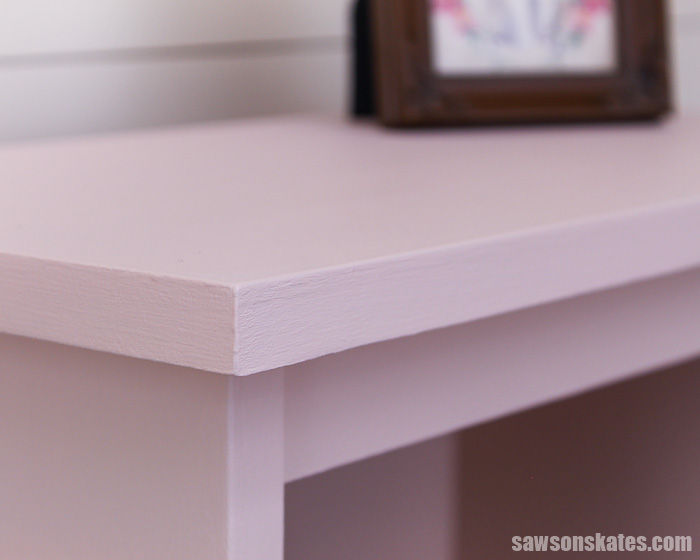
How Do You Finish the Bookshelf?
This DIY bookshelf could be finished in a variety of ways. It could be left natural, painted, stained, or a combination of paint and stain.
I chose to paint my bookcase. First, I applied a coat of primer and then painted it with two coats of Behr “Life is a Peach”.
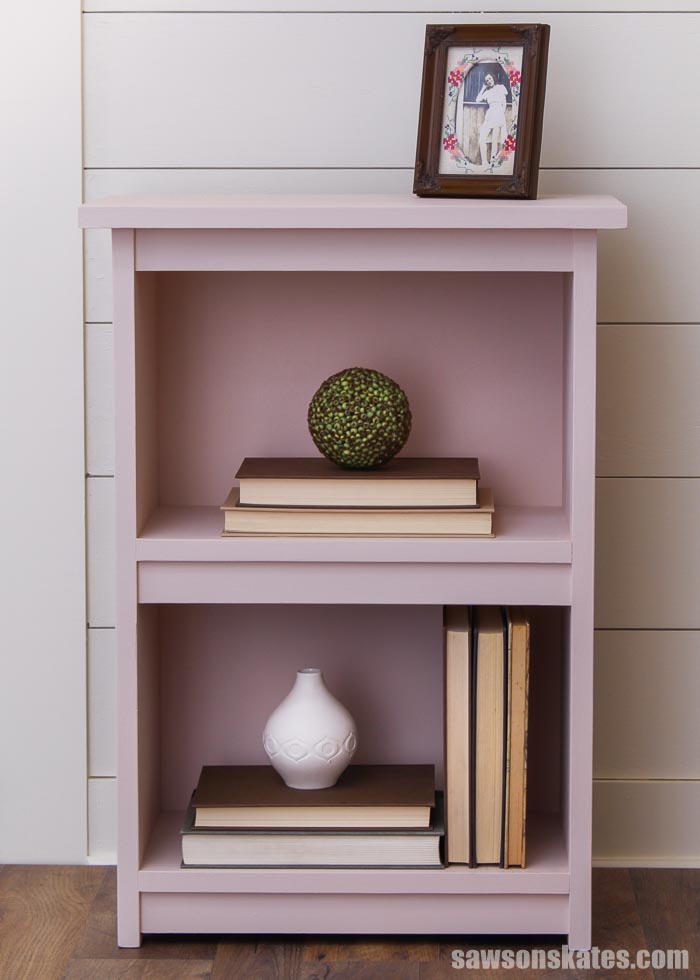
Customize Your Bookshelf
There are a few ways to customize this do it yourself bookshelf. You could adjust the size, add adjustable shelves, or both.
Make it Taller
The height between the shelves measures about 9-⅜”. You could increase the height of the side panels to increase the spacing between the shelves.
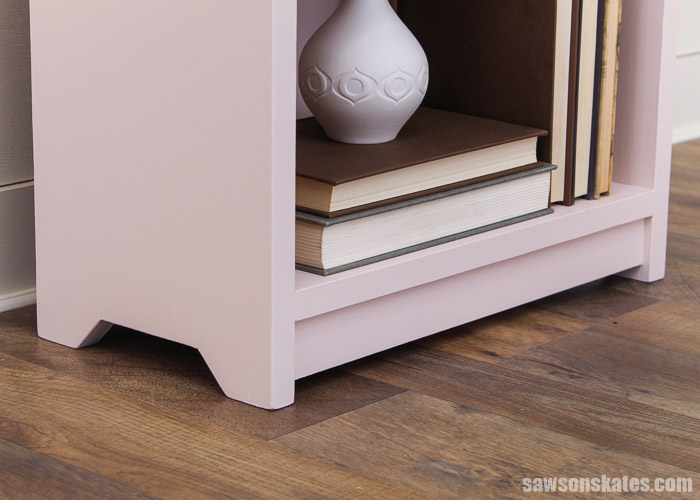
Add Adjustable Shelves
This bookshelf was designed with fixed shelves, but you could easily add adjustable shelves just like I did for this DIY end table.
For the end table, I used my Kreg Shelf Pin Jig to drill shelf pin holes in the sides of the cabinet. Shelf pins are then installed in the holes to support the shelves.
The adjustable shelves can be positioned to store books, magazines, and more.
The jig is simple to use and works similar to a pocket hole jig. Just clamp the shelf pin jig to the board and drill through the guides in the jig.
Related: How to Use a Shelf Pin Jig

Simple DIY Bookshelf
Printed Plan
- Get the FREE plan here (includes detailed instructions, measurements, and bonus tips).
Supplies
- Wood (per printed plan)
- 1-¼” Coarse-Thread Pocket Screws
- 1-¼” Fine-Thread Pocket Screws
- ½” Pin Nails or Brad Nails
- Wood Glue
Tools
- Tape Measure
- Drill
- Kreg Jig
- Kreg Multi-Mark
- Miter Saw
- Jigs Saw, Circular Saw, or Table Saw
- Hammer or Nail Gun
Step 1. Make the Sides
Cut 4 pieces of wood to length for the outer sections of the sides and cut a 45-degree angle on one end.
Cut 2 pieces of wood to length for the inner section of the sides.
Apply glue to the edges and clamp to form two panels.
Related: How to Edge Join with Pocket Holes

When the glue is dry, drill pocket holes at the top of each side panel. These pocket holes will be used to attach the sides to the top.
Related: How to Use a Kreg Jig
Step 2. Attach the Shelves
Cut 6 pieces of wood to length for the shelves. Apply glue to the edges and clamp.
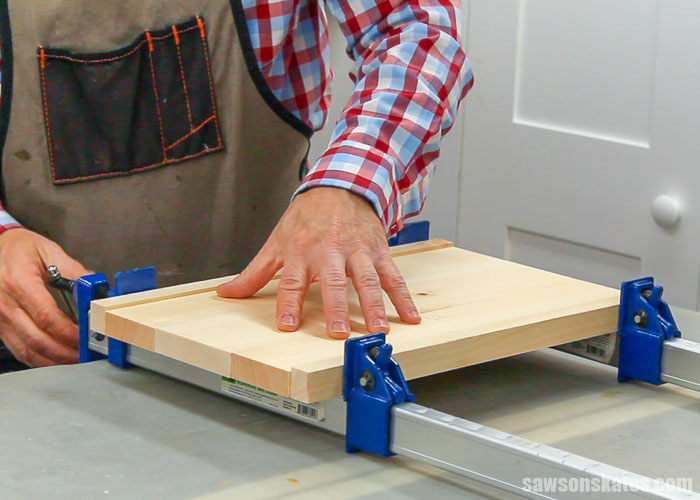
When the glue is dry, drill pocket holes in the end of each shelf.
Place the middle shelf in position, clamp it to the side panels, and attached using pocket screws.
Then, place the bottom shelf in position, clamp it to the side panels, and attached using pocket screws.
Step 3. Attach the Rails
Cut 6 pieces of wood to length for the rails and drill pocket holes in each end.
Position the rails at the top of the sides, and below the middle shelf and the bottom shelf. Attach using pocket screws.
Step 4. Attach the Top
Cut 3 pieces of wood to length for the top. Apply glue to the edges, and clamp.
When the glue was dry, center the top on the sides, clamp, and attach using pocket screws.
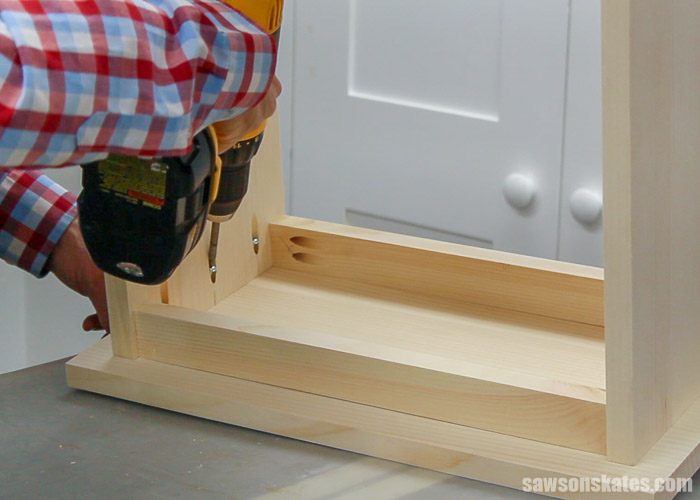
In many cases, I recommend not to use pocket screws to attach a table top. Instead, I recommend attaching a table top with table top fasteners which allow for wood movement.
Related: How to Attach a Table Top to a Base (The Right Way)
This project is an exception.
The reason is, the wood grain of the table top and the side panels are oriented in the same direction.
The table top and side panels will expand across their width or from front to back of this piece. There are no fasteners or cross members that will prevent this movement. This should reduce the chances of the wood cracking or splitting.
Related: Mistakes with Wood Can Cause Your DIY Furniture to Crack
Step 5. Attach the Back
Cut 1 piece of hardboard to size for the back panel. I used my table saw to cut this piece, but you could also use a jig saw or a circular saw instead.
Related:
I positioned the back panel on the case, traced around the edge with a pencil, and then removed the back. Next, I applied glue within the pencil lines and placed the back panel in position.
I used my pin nailer and ½” pin nails to tack the back in place, but you could also attach the back without nails. Just clamp the back to the case and allow the glue to dry.
Related: Pin Nailer vs Brad Nailer: Differences & Which to Use
Step 6. Finish the Bookshelf
This DIY bookshelf could be finished in a variety of ways. It could be left natural, painted, stained, or a combination of paint and stain.
I chose to paint my bookcase. First, I applied a coat of primer and then painted it with two coats of Behr “Life is a Peach”.
Final Thoughts
This bookshelf is an easy afternoon do-it-yourself project. The simple style complements nearly any decor. The small size makes this bookcase a smart choice for any room.
Get the free plan (including the detailed instructions and measurements) now!
Thank you for stopping by. If you enjoyed this tutorial, would you please take a moment and pin it to Pinterest? I’d really appreciate it!

